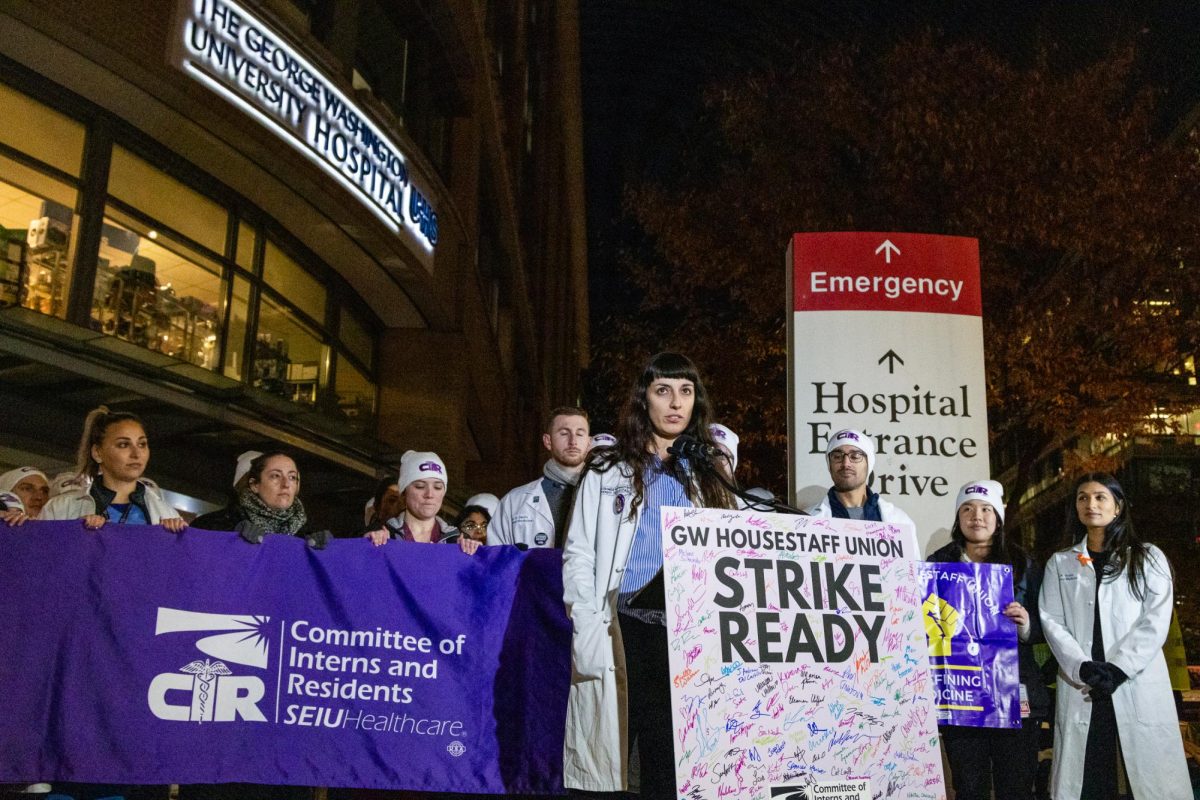Officials say planned cuts to enrollment will not generate any new debt, but faculty senators aren’t convinced.
A 2015 report by the Faculty Senate’s finance committee found the University’s debt at the time – totaling $1.66 billion – could limit GW’s growth and hamper any efforts to improve GW’s reputation. But officials said major planned changes to the University’s enrollment – including the decrease in total enrollment and increase in the ratio of STEM majors – will not grow the University’s nearly $2 billion of debt.
Executive Vice President and Chief Financial Officer Mark Diaz said the University currently owes $1.9 billion in debt as of June 30, 2019. Diaz said the University has paid $344 million in interest on the debt from fiscal years 2015 to 2019.
“The University has always managed its debt portfolio in a comprehensive and strategic manner, with particular focus on managing risk and cost of capital, which support the liquidity needs of the institution,” he said in an email.
Diaz said the University’s planned enrollment cut will not change the size of GW’s debt.
University President Thomas LeBlanc kicked off the planning process for GW’s next strategic plan last semester after announcing the STEM increase last spring and the enrollment cut over the summer. Last semester, faculty raised concerns about administrators’ lack of transparency during the planning process and about potential effects on the University’s finances.
Six enrollment models presented by the Office of the Provost in October projected revenue losses of $8 million to $36.2 million per year and losses in underrepresented minority enrollment from 2 to 7 percent. LeBlanc said at a December Faculty Senate meeting that those models were preliminary, adding that officials do not intend to compromise “an inch” on diversity gains.
Diaz added that the size of GW’s debt has not affected faculty hires and the number of construction projects on campus – two concerns raised by the Faculty Senate five years ago – as a consequence of the University’s debt structure. Rather than make continual payments on the principal amount of debt, officials must make lump sum payments on GW’s loans once they mature, he said.
Diaz said the University continues to issue bonds to refinance its debt at a lower interest rate to invest in campus projects and to realize new revenue sources, like the real estate development project that resulted in Residences on the Avenue.
“The last bond issuance was part of GW’s overall financial strategy to monetize incremental investment real estate cash flow, invest in projects that are important to the University and refinance debt with extended maturities and lower cost of capital, saving money over time,” he said.
Members of the senate’s fiscal planning and budgeting committee said the enrollment changes will likely result in larger budget deficits, but they added that officials can correct their course by adjusting the plan over four years to minimize its financial impact.
Donald Parsons, a professor of economics who penned the debt report five years ago, said he does not see how the University will cover the enrollment plan’s costs without increasing debt because GW’s budget does not include enough funding to absorb the costs of the plan, which officials have not yet finalized.
“They are still struggling with what the plan is so they can’t cost it out yet, then how much of it has to come out of debt?” he said. “I dare say it’s most of it. There is not a lot of money there to spend.”
Parsons said that given the projected deficits caused by the enrollment decrease, the only way to make the move budget neutral is to hire more adjunct faculty, who generally receive lower pay than full-time professors. Officials previously hired lots of adjunct faculty while growing enrollment under former University President Stephen Trachtenberg to improve GW’s financial situation, he said.
“Assuming they don’t find it hard to fire tenured faculty, I believe the only space to adjust is in adjuncts, who are cheap,” Parsons said.
Parsons said he is concerned about how officials plan to keep debt in check with the increasing proportion of STEM students, whose education is more costly than non-STEM students. He said many STEM majors receive scholarships that push them to commit to GW, which costs the University tuition revenue.
“At the same time they want STEM to increase, but we have horrible trouble attracting STEM students because we are not a STEM university,” Parsons said.
Anthony Yezer, a professor of economics and a member of the committee, said GW’s debt has almost doubled in the past decade to its present level of nearly $2 billion. Some faculty members believe that administrators’ previous fiscal and academic planning has been “substandard” because GW’s academic standing has not improved under the increasing debt, he said.
“It is not clear to me that GW’s academic reputation or status has benefited from this substantial increase in debt,” Yezer said in an email.
Yezer said he is not as concerned about the potential need to borrow $64 million, which LeBlanc said is the projected cost of the enrollment changes over four years, but he is concerned about the University’s debt coverage ratio, which measures the University’s net operating income over the portion of income that goes toward servicing debt – paying off either the debt itself or interest on debt.
Yezer said administrators will have to take steps to ensure the University has a significant financial margin available to pay back creditors.
He said the most recent rating GW received from Moody’s Investor Service in 2018 mentioned that the University had a more than 10 percent operating cash flow margin, adding that the rating agency deemed GW “stable” in terms of its financial outlook.
“A fall in operating margins that lasted more than one or two years would likely produce a downgrade from Moody’s,” Yezer said. “I trust that GW would formulate plans to avoid that contingency.”
A downgrade in ratings from a credit agency would mean GW’s cost of borrowing money would increase.
He added that officials will have opportunities to minimize GW’s losses throughout the plan’s four years of cuts by changing the size of each successive class enrolled, which provides officials with a “major source of flexibility.”
Officials plan to admit 2,250 full-time freshmen, excluding transfers, in next year’s class, LeBlanc said at a senate meeting in December. That figure represents an 11.7 percent cut in enrollment from the University’s baseline of 2,550 students per class, according to provost office’s models.
“There is lots of opportunity for mid-course correction to avoid such a large number,” Yezer said.








